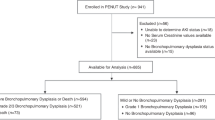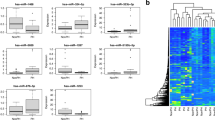Abstract
Background:
Bronchopulmonary dysplasia (BPD) portends lifelong organ impairment and death. Our ability to predict BPD in first days of life is limited, but could be enhanced using novel biomarkers.
Methods:
Using an available clinical and urine biomarker database obtained from a prospective 113 infant cohort (birth weight ≤1,200 g and/or gestational age ≤31 wk), we evaluated the independent association of 14 urine biomarkers with BPD/mortality.
Results:
Two of the 14 urine biomarkers were independently associated with BPD/mortality after controlling for gestational age (GA), small for gestational age (SGA), and intubation status. The best performing protein was clusterin, a ubiquitously expressed protein and potential sensor of oxidative stress associated with lung function in asthma patients. When modeling for BPD/mortality, the independent odds ratio for maximum adjusted urine clusterin was 9.2 (95% CI: 3.3–32.8, P < 0.0001). In this model, clinical variables (GA, intubation status, and SGA) explained 38.3% of variance; clusterin explained an additional 9.2%, while albumin explained an additional 3.4%. The area under the curve incorporating clinical factors and biomarkers was 0.941.
Conclusion:
Urine clusterin and albumin may improve our ability to predict BPD/mortality. Future studies are needed to validate these findings and determine their clinical usefulness.
Similar content being viewed by others
Log in or create a free account to read this content
Gain free access to this article, as well as selected content from this journal and more on nature.com
or
References
Ambalavanan N, Carlo WA. Bronchopulmonary dysplasia: new insights. Clin Perinatol 2004;31:613–28.
Coalson JJ. Pathology of bronchopulmonary dysplasia. Semin Perinatol 2006;30:179–84.
Tooley WH. Epidemiology of bronchopulmonary dysplasia. J Pediatr 1979;95(5 Pt 2):851–8.
Shennan AT, Dunn MS, Ohlsson A, Lennox K, Hoskins EM. Abnormal pulmonary outcomes in premature infants: prediction from oxygen requirement in the neonatal period. Pediatrics 1988;82:527–32.
Askenazi D, Patil NR, Ambalavanan N, et al. Acute kidney injury is associated with bronchopulmonary dysplasia/mortality in premature infants. Pediatr Nephrol 2015;30:1511–8.
Askenazi DJ, Koralkar R, Patil N, et al. Acute kidney injury urine biomarkers in very low-birth-weight infants. Clin J Am Soc Nephrol 2016;1:1527–35.
Saeidi B, Koralkar R, Griffin RL, Halloran B, Ambalavanan N, Askenazi DJ. Impact of gestational age, sex, and postnatal age on urine biomarkers in premature neonates. Pediatr Nephrol 2015;30:2037–44.
Laughon MM, Langer JC, Bose CL, et al.; Eunice Kennedy Shriver National Institute of Child Health and Human Development Neonatal Research Network. Prediction of bronchopulmonary dysplasia by postnatal age in extremely premature infants. Am J Respir Crit Care Med 2011;183:1715–22.
Onland W, Debray TP, Laughon MM, et al. Clinical prediction models for bronchopulmonary dysplasia: a systematic review and external validation study. BMC Pediatr 2013;13:207.
Jones SE, Jomary C. Clusterin. Int J Biochem Cell Biol 2002;34:427–31.
Koltai T. Clusterin: a key player in cancer chemoresistance and its inhibition. Onco Targets Ther 2014;7:447–56.
Sansanwal P, Li L, Sarwal MM. Inhibition of intracellular clusterin attenuates cell death in nephropathic cystinosis. J Am Soc Nephrol 2015;26:612–25.
Lin CC, Tsai P, Sun HY, et al. Apolipoprotein J, a glucose-upregulated molecular chaperone, stabilizes core and NS5A to promote infectious hepatitis C virus virion production. J Hepatol 2014;61:984–93.
Lee YN, Shim YJ, Kang BH, Park JJ, Min BH. Over-expression of human clusterin increases stress resistance and extends lifespan in Drosophila melanogaster. Biochem Biophys Res Commun 2012;420:851–6.
Trougakos IP. The molecular chaperone apolipoprotein J/clusterin as a sensor of oxidative stress: implications in therapeutic approaches - a mini-review. Gerontology 2013;59:514–23.
Li JY, Liu J, Jiang J, et al. Calcium oxalate calculi-induced clusterin expression in kidney. Urolithiasis 2015;43:411–8.
Girton RA, Sundin DP, Rosenberg ME. Clusterin protects renal tubular epithelial cells from gentamicin-mediated cytotoxicity. Am J Physiol Renal Physiol 2002;282:F703–9.
Kwon HS, Kim TB, Lee YS, et al. Clusterin expression level correlates with increased oxidative stress in asthmatics. Ann Allergy Asthma Immunol 2014;112:217–21.
Doi K, Ishizu T, Fujita T, Noiri E. Lung injury following acute kidney injury: kidney-lung crosstalk. Clin Exp Nephrol 2011;15:464–70.
Ko GJ, Rabb H, Hassoun HT. Kidney-lung crosstalk in the critically ill patient. Blood Purif 2009;28:75–83.
Karimi Z, Ketabchi F, Alebrahimdehkordi N, et al. Renal ischemia/reperfusion against nephrectomy for induction of acute lung injury in rats. Ren Fail. 2016;3:1–16.
Faubel S, Shah PB. Immediate consequences of acute kidney injury: the impact of traditional and nontraditional complications on mortality in acute kidney injury. Adv Chronic Kidney Dis 2016;23:179–85.
Hong GH, Kwon HS, Moon KA, et al. Clusterin modulates allergic airway inflammation by attenuating CCL20-mediated dendritic cell recruitment. J Immunol 2016;196:2021–30.
Acknowledgements
The authors wish to thank Emma Perez-Costas, PhD (Department of Pediatrics, University of Alabama at Birmingham) who performed substantive science editing as well as proofreading of this manuscript.
Author information
Authors and Affiliations
Corresponding author
Supplementary information
Supplementary Figures
(PDF 515 kb)
Supplementary Table S1
(DOCX 13 kb)
PowerPoint slides
Rights and permissions
About this article
Cite this article
Balena-Borneman, J., Ambalavanan, N., Tiwari, H. et al. Biomarkers associated with bronchopulmonary dysplasia/mortality in premature infants. Pediatr Res 81, 519–525 (2017). https://doi.org/10.1038/pr.2016.259
Received:
Accepted:
Published:
Issue date:
DOI: https://doi.org/10.1038/pr.2016.259
This article is cited by
-
Premature infants born <28 weeks with acute kidney injury have increased bronchopulmonary dysplasia rates
Pediatric Research (2023)
-
Gestational age, sex, and time affect urine biomarker concentrations in extremely low gestational age neonates
Pediatric Research (2022)
-
Development of severe bronchopulmonary dysplasia is associated with alterations in fecal volatile organic compounds
Pediatric Research (2018)



